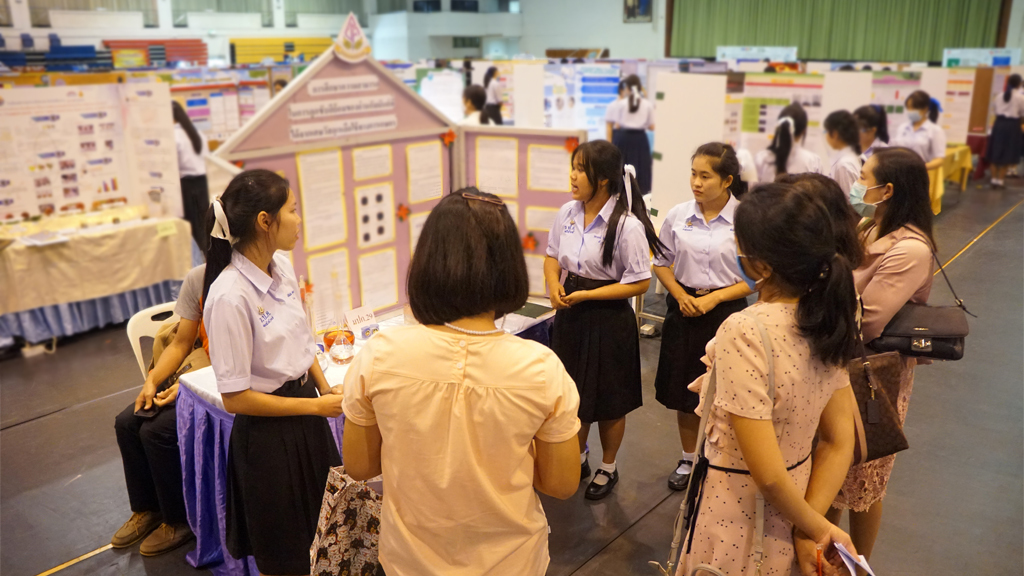Brief
High School Science and Engineering Fairs: Lessons Learned
Connected Science Learning September–October 2022 (Volume 4, Issue 5)
By Frederick Grinnell and Simon Dalley

Approximately 250,000 U.S. high school students participate in science and engineering fairs (SEFs) every year. Science and engineering fairs offer students an opportunity to experience for themselves the practices described by Next Generation Science Standards.
For most students, SEF participation begins in their schools. However, as the level of SEF competition progresses from school to district to regional to state to national, the out-of-school community becomes more and more involved with science fair directors and their advisory committees, coordinating SEF activities including recruiting large numbers of volunteer judges from academia, industry, and the community. In this sense SEFs represent a paradigmatic example of school and community partnerships engaged in STEM education.
About seven years ago, we began a systematic investigation of student experiences in high school SEFs using anonymous and voluntary surveys including quantitative and qualitative (open-ended text) questions carried out with regional and national groups of high school students and post–high school students. The following recommendations and conclusions are based on what we have learned from almost 3,000 students.
School Science Programs
Incentivize rather than require competitive SEFs. Most students don’t like the SEF requirement (4:1). Being required to participate has negative consequences: (1) decreased likelihood that students indicate participation increased their interests in science and engineering, and (2) increased likelihood of research misconduct if the student was not interested in science and engineering. In the latter case, approximately 10% indicated that they made up their data or used someone else’s data vs. 2–3% otherwise if participation was voluntary.
Science Fair Organizers
Recognize different SEF objectives for 9th/10th vs. 11th/12th grades. Most high school students who participate in SEFs do so in 9th and 10th grades (75%). However, high school students who participate in the earlier grades are less interested in science and engineering careers, e.g., 50% of 9th graders vs. 80% of 12th graders. In their comments, the students emphasized that competitive SEFs are about winning not learning, whereas non‑competitive SEFs provide an opportunity to learn scientific-thinking skills and research skills. Perhaps students in 9th and 10th grades should have the option to be assessed differently compared to 11th and 12th grades (e.g., mastery vs. performance) to emphasize the difference between science for everyone vs. science for the scientists and engineers of the future.
Academia and Industry Beyond the Role of Judging
- Develop outreach programs to help students with their projects. About 7% of students overall indicated that they received help from scientists. Eighty percent of those students advanced to SEF competitions beyond the school-only level and approximately 80% indicated that their SEF experiences increased their interests in science and engineering compared to approximately 50% of students without help from scientists. Black students, who were least likely to advance to SEFs beyond the school level, also were least likely—less than 3%—to indicate that they received help from scientists.
- Develop outreach programs to provide students with coaching for the SEF interview. Less than 20% of students received coaching for the interview. However, more than any other type of help, students who received coaching indicated that SEF participation increased their interests in science and engineering—fourfold for Black students, threefold for Asian and Hispanic students, and slightly less than twofold for White students.
The lessons learned from our research offer ideas for enhancing SEFs ranging from school science programs to science fair organizers to scientists and engineers in the community so as to make SEFs more effective, inclusive and equitable learning opportunities, thereby enhancing successful student participation and outcomes.
Frederick Grinnell is Robert McLemore Professor of Medical Science at the UT Southwestern Medical Center and Simon Dalley is Director of Undergraduate Studies and Assistant Chair of Physics at Southern Methodist University, both in Dallas, Texas.
citation: Grinnell, F., and S. Dalley. 2022. High school science and engineering fairs: Lessons learned. Connected Science Learning 4 (5). https://www.nsta.org/connected-science-learning/connected-science-learning-september-october-2022/high-school-science
Inquiry Labs NGSS Research Science and Engineering Practices STEM Three-Dimensional Learning High School Informal Education


